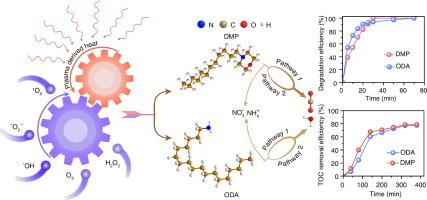Gas-liquid pulse-modulated plasma with bubbling concomitant with plasma-derived heat enhanced degradation of the octadecylamine and 4-dodecylmorpholine: Performance and mechanism insight
IF 8.1
1区 工程技术
Q1 ENGINEERING, CHEMICAL
引用次数: 0
Abstract
A gas–liquid pulse-modulated plasma with bubbling coupled with plasma-derived heat system was developed for efficient degradation of octadecylamine (ODA) and 4-dodecylmorpholine (DMP). The structure–activity relationship between high-voltage electrode structures and the degradation activity of ODA and DMP was delved into using fluid dynamics simulations. The crucial role of bubbling is evident in the enhancement of ODA and DMP degradation efficiencies by 100% and 47% within 30 min, respectively. ODA and DMP degradation efficiencies reached 96% and 100% with treatment of 30 min, respectively, accompanied by a high mineralization efficiency of 80 %. An in-depth analysis was performed on the evolution of the physicochemical properties of the reaction solution during degradation. The plasma coupled with plasma-derived heat system exhibited remarkable synergistic effects, achieving synergistic intensities of 0.96 for ODA and 1.28 for DMP, with energy efficiencies increased by 31% and 16%. Analysis of the evolution of total nitrogen and nitrogen-containing species revealed that ODA and DMP degradation commenced with the decomposition of amino groups, ultimately converting them into and . Quenching tests and electron spin resonance characterization confirmed the generation of , and , with playing a pivotal role in the degradation process. Furthermore, the possible degradation pathways of ODA and DMP were elucidated by the theoretical calculations and gas chromatography-mass spectrometry results, respectively. The toxicity evaluation of degradation intermediates demonstrated a consistent decrease in toxicity during the degradation process. This study advances our understanding of the synergistic potential of plasma-plasma-derived heat systems for pollutant degradation and paves the way for the development of more effective pollutant degradation technologies.


求助全文
约1分钟内获得全文
求助全文
来源期刊

Separation and Purification Technology
工程技术-工程:化工
CiteScore
14.00
自引率
12.80%
发文量
2347
审稿时长
43 days
期刊介绍:
Separation and Purification Technology is a premier journal committed to sharing innovative methods for separation and purification in chemical and environmental engineering, encompassing both homogeneous solutions and heterogeneous mixtures. Our scope includes the separation and/or purification of liquids, vapors, and gases, as well as carbon capture and separation techniques. However, it's important to note that methods solely intended for analytical purposes are not within the scope of the journal. Additionally, disciplines such as soil science, polymer science, and metallurgy fall outside the purview of Separation and Purification Technology. Join us in advancing the field of separation and purification methods for sustainable solutions in chemical and environmental engineering.
 求助内容:
求助内容: 应助结果提醒方式:
应助结果提醒方式:


